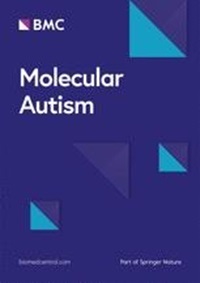Shank3 缺乏症通过激活下丘脑 AgRP 神经元中的 p38α 引发自闭症样行为
IF 6.3
1区 医学
Q1 GENETICS & HEREDITY
引用次数: 0
摘要
SH3和多杏仁蛋白重复结构域蛋白3(SHANK3)单基因突变或缺乏会导致过度的刻板行为和社交能力受损,这在自闭症病例中经常出现。迄今为止,Shank3突变或缺失导致自闭症的潜在机制以及Shank3突变导致自闭症表型的大脑部位还未得到充分研究。下丘脑与刻板行为和交际能力有关。p38α是大脑炎症反应的介质,被认为是某些自闭症病例的潜在基因。然而,尚不清楚下丘脑和 p38α 是否与 Shank3 突变或缺乏导致的自闭症发病有关。研究人员利用京都基因组百科全书(KEGG)通路分析和免疫印迹法评估了Shank3基因敲除(Shank3-/-)小鼠下丘脑中交替的信号通路。家庭笼实时监测试验用于记录小鼠的刻板行为,三室试验用于监测小鼠的社会性。使用腺相关病毒9(AAV9)在弓状核(ARC)或激动相关肽(AgRP)神经元中表达p38α。D176A 和 F327S 突变表达组成活性 p38α。T180A 和 Y182F 突变表达了非活性 p38α。我们发现,Shank3通过调节AgRP神经元中p38α的活性来控制刻板行为和社会性。Shank3-/-小鼠下丘脑中磷酸化的p38水平显著升高。同样,在ARC或AgRP神经元中过表达p38α会引起野生型(WT)小鼠过度的刻板行为并损害其社交能力。值得注意的是,激活 AgRP 神经元中的 p38α 会增加刻板行为并损害社交能力。相反,AgRP 神经元中的 p38α 失活会显著改善 Shank3-/- 小鼠的自闭症行为。与此相反,激活原绒毛膜促皮质素(POMC)神经元中的 p38α 不会影响小鼠的刻板行为和社会性。我们证实,SHANK3 可调节下丘脑中磷酸化 p38 的水平,而 AgRP 神经元中的 p38α 失活可显著改善 Shank3-/- 小鼠的自闭症行为。然而,我们并未阐明 SHANK3 抑制 AgRP 神经元中 p38α 的生化机制。这些结果表明,Shank3缺陷通过激活AgRP神经元中的p38α信号转导而导致类似自闭症的行为,表明AgRP神经元中的p38α信号转导是Shank3突变相关自闭症的潜在治疗靶点。本文章由计算机程序翻译,如有差异,请以英文原文为准。
Shank3 deficiency elicits autistic-like behaviors by activating p38α in hypothalamic AgRP neurons
SH3 and multiple ankyrin repeat domains protein 3 (SHANK3) monogenic mutations or deficiency leads to excessive stereotypic behavior and impaired sociability, which frequently occur in autism cases. To date, the underlying mechanisms by which Shank3 mutation or deletion causes autism and the part of the brain in which Shank3 mutation leads to the autistic phenotypes are understudied. The hypothalamus is associated with stereotypic behavior and sociability. p38α, a mediator of inflammatory responses in the brain, has been postulated as a potential gene for certain cases of autism occurrence. However, it is unclear whether hypothalamus and p38α are involved in the development of autism caused by Shank3 mutations or deficiency. Kyoto Encyclopedia of Genes and Genomes (KEGG) pathway analysis and immunoblotting were used to assess alternated signaling pathways in the hypothalamus of Shank3 knockout (Shank3−/−) mice. Home-Cage real-time monitoring test was performed to record stereotypic behavior and three-chamber test was used to monitor the sociability of mice. Adeno-associated viruses 9 (AAV9) were used to express p38α in the arcuate nucleus (ARC) or agouti-related peptide (AgRP) neurons. D176A and F327S mutations expressed constitutively active p38α. T180A and Y182F mutations expressed inactive p38α. We found that Shank3 controls stereotypic behavior and sociability by regulating p38α activity in AgRP neurons. Phosphorylated p38 level in hypothalamus is significantly enhanced in Shank3−/− mice. Consistently, overexpression of p38α in ARC or AgRP neurons elicits excessive stereotypic behavior and impairs sociability in wild-type (WT) mice. Notably, activated p38α in AgRP neurons increases stereotypic behavior and impairs sociability. Conversely, inactivated p38α in AgRP neurons significantly ameliorates autistic behaviors of Shank3−/− mice. In contrast, activated p38α in pro-opiomelanocortin (POMC) neurons does not affect stereotypic behavior and sociability in mice. We demonstrated that SHANK3 regulates the phosphorylated p38 level in the hypothalamus and inactivated p38α in AgRP neurons significantly ameliorates autistic behaviors of Shank3−/− mice. However, we did not clarify the biochemical mechanism of SHANK3 inhibiting p38α in AgRP neurons. These results demonstrate that the Shank3 deficiency caused autistic-like behaviors by activating p38α signaling in AgRP neurons, suggesting that p38α signaling in AgRP neurons is a potential therapeutic target for Shank3 mutant-related autism.
求助全文
通过发布文献求助,成功后即可免费获取论文全文。
去求助
来源期刊

Molecular Autism
GENETICS & HEREDITY-NEUROSCIENCES
CiteScore
12.10
自引率
1.60%
发文量
44
审稿时长
17 weeks
期刊介绍:
Molecular Autism is a peer-reviewed, open access journal that publishes high-quality basic, translational and clinical research that has relevance to the etiology, pathobiology, or treatment of autism and related neurodevelopmental conditions. Research that includes integration across levels is encouraged. Molecular Autism publishes empirical studies, reviews, and brief communications.
 求助内容:
求助内容: 应助结果提醒方式:
应助结果提醒方式:


